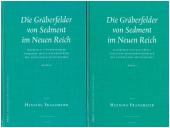 Neuerscheinungen 2017Stand: 2020-02-01 |
Schnellsuche
ISBN/Stichwort/Autor
|
Herderstraße 10
10625 Berlin
Tel.: 030 315 714 16
Fax 030 315 714 14
info@buchspektrum.de |

Henning Franzmeier
Die Gräberfelder von Sedment im Neuen Reich, 2 vols.
Materielle und kulturelle Variation im Bestattungswesen des ägyptischen Neuen Reiches
2017. LXX, 1882 S. 235.0 mm
Verlag/Jahr: BRILL 2017
ISBN: 9004343423 (9004343423)
Neue ISBN: 978-9004343429 (9789004343429)
Preis und Lieferzeit: Bitte klicken
In Die Gräberfelder von Sedment im Neuen Reich , Henning Franzmeier reassesses the partially published excavations of W.M.F. Petrie and G. Brunton in the New Kingdom cemeteries of Sedment, Middle Egypt, significantly expanding the corpus of known tombs and objects.
In Die Gräberfelder von Sedment im Neuen Reich , Henning Franzmeier presents and reassesses the complete results of the previously only partially published excavations undertaken by W.M.F. Petrie and G. Brunton in the New Kingdom cemeteries of Sedment, Middle Egypt, from 1920 to 1921. Through his research, Franzmeier has expanded the corpus of known New Kingdom tombs at Sedment from about 50 to more than 250, including burials of high-ranking officials, and identified a wide range of previously unknown objects. Presenting the development of an important provincial cemetery, this publication provides a valuable contribution to our understanding of New Kingdom Egyptian funerary archaeology and, as a case study, highlights the potentials of reassessing the results of past excavations.
Volume 1
Abbildungsverzeichnis
Hinweise zur Benutzung
1. Einleitung
2. Forschungsgeschichte der Nekropolen von Sedment
3. Die Grabung 1920/21 und das genutzte Quellenmaterial
4. Chronologie und Typologie
5. Die Gräberfelder und ihre Entwicklung
6. Die Architektur der Gräber
7. Auswertung - Bestattungssitten, soziale und kulturelle Differenzierung
8 Die bestatteten Personen
Appendices
Bibliografie
Volume 2
Einleitung
Katalog
Tafeln
Henning Franzmeier , University College London/Roemer- und Pelizaeus-Museum Hildesheim, is field director of the Qantir-Pi-Ramesse project. He has published a monograph and many articles, focusing on the archaeology of New Kingdom Egypt.


